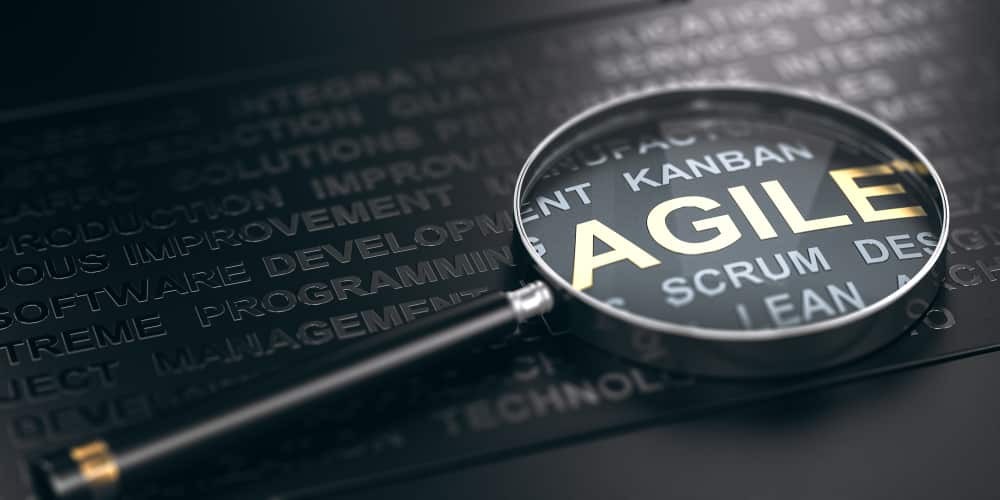Agile has changed the way that projects are managed and how software is developed. Therefore, there is now a greater need for IT experts that are familiar with the technique and its subsets, such as Lean, Kanban, Scrum, and Scaled Agile for businesses.
Are you also planning to kickstart your career in it? An agile career is a self-reflective, evolutionary professional path that is motivated by adaptability and several job opportunities. Some of the popular ones you can land are project manager, program manager, agile coach, scrum master, and many more. Let us look at some of the popular agile interview questions.
- Agile Methodology Interview Questions
- What is Agile Methodology?
- What is Scrum in Agile?
- What do all Agile frameworks have in common?
- What is Agile Testing?
- What is a sprint in Agile?
- What does not match with the Agile Manifesto?
- What is Agile Software Development?
- Which of these are Agile Estimation Techniques?
- How does an Agile team maintain requirements?
- Agile Methodology FAQs
- Conclusion
Sprints are a set of project management and software development practices to create customer-centric solutions in short cycles. It’s an iterative process, with each iteration planned to be modest and manageable so that it can be completed in a certain amount of time. Agile approaches are flexible enough to adapt to changing requirements over time and promote end-user feedback. This blog talks about the top Agile Interview Questions for you to ace your upcoming interview.
Agile Methodology Interview Questions
Let’s dive into the top Agile Interview Questions you can expect the next time you face an interview.
What is Agile methodology?
The Agile approach is a specific project management approach used for software development. This approach assists teams in responding to software uncertainty. It uses a growing, increasingly sequential work sequence known as sprints. In lament terms, it is a type of project management process mainly used for software development where the needs and solutions change through the collaborative effort of their clients’ self-organizing and working teams.
Agile is a process in which a team can manage a project by dividing it into several phases. It involves regular interaction with stakeholders and continuous improvement and photography at all stages. The Agile approach starts with customers explaining how the final product will be used and what problem it will solve.
This clarifies the client’s expectations of the project team. Once the work has begun, teams go through a process of planning, performing, and evaluating – which can simply change the last delivery to better-fit customer needs. Ongoing collaboration is essential, both between team members and project stakeholders, to make informed decisions.
Why agile?
Agile allows teams to deliver a specific type and develop it throughout the cycle. It supports common problem-solving and collaboration. Agile helps teams and individuals prioritize features and performance in general. Groups can make quick course adjustments depending on participants’ feedback.
What is Scrum in Agile?
A scrum is a process framework used to manage product development and other information work. A scrum is powerful because it allows teams to develop an idea of how something works, try it out, consider what happened, and make appropriate adjustments. That is when the framework is used correctly.
The scrum is structured in such a way that it allows teams to incorporate practices from other structures in which they make sense of the team context.
A scrum is a framework that helps teams work together. Like a rugby team (from which it gets its name) training for the big game, Scrum encourages teams to learn from experience, organize themselves while working through a crisis, and think about their wins and defeats to progress further.
While software development teams widely use the Scrum we are talking about, its principles and lessons can be applied to all types of interactions. This is one of the reasons why Scrum is so popular. Often thought of as an agile project management framework, Scrum describes a set of meetings, tools, and roles that work in concert to help teams plan and manage their work.
What do all Agile frameworks have in common?
Agile software development was introduced to overcome the challenges facing the life cycle of software development. Any software life cycle uses four values and 12 principles defined in agile manifestations using agile. There are a few agile frameworks such as Scrum, Kanban, and XP (Extreme programming) for agile implementation.
The primary common purpose of an agile framework such as Scrum, XP, or Kanban is to be able to change the process after starting the product according to the requirements. All agile frameworks follow the add-on approach, and project details can be changed during the software development cycle.
All agile frameworks have a fixed, moderate iteration length, a lightweight approach that allows self-organizing teams to respond better to business needs, and recurring and increasing development.
It is a term that is involved in software development methods. Each type of development has an Agile framework. The whole agile framework is used for software’s growing and repetitive growth.
Includes set lengths of repetition; simple weight makes the engineering work individually. Build an app with experimental upgrades.
The use of continuous feedback is involved in the development process. It includes the testing, integration, and constant development of various species.
What is Agile testing?
Agile testing is a practice of testing that follows the rules and principles of fast software development. Unlike the Waterfall approach, Agile Testing can start at the beginning of a project with a continuous link between development and testing. The Agile test method is inconsistent (in the sense that it is only done after the coding phase) but is constant.
The agile testing strategy supports DevOps and ongoing testing. And further testing is essential to improving product quality.
In Agile development, testing needs to happen early and often. Therefore, instead of waiting for the development to be completed before testing, testing takes place continuously as features are added.
Experiments are prioritized as user issues. The testers aim to get as many tests as possible in the iteration. Adding automated test tools can help testers go through a lot of testing back.
What is a sprint in Agile?
Sprint is a short, time-consuming period in which a scrum team works to complete a set amount of work. Sprints are at the heart of scrum and agile methods, and getting good sprints will help your agile team deliver the best software in a few headers.
Using Agile project management methods, projects are divided into sprints or iterations. These are short, repetitive sections, usually one to four in length. Each sprint should lead to a draft, specific type, or active form of the final project being submitted.
The purpose of the sprints is to break down the project into degrees with a bite scale. This allows the team to schedule one sprint at a time and convert future sprints according to the result of the sprints already completed.
While planning occurs at the beginning of each sprint, the number of sprints should be determined at the beginning of the project. The sprint in Agile needs to be written in a timeline, and each sprint should be of equal length.
What does not match with the Agile Manifesto?
Agile Manifesto is a type of price with specific organizational guidelines for delivering software very quickly to meet participants’ expectations.
Four key points in the Manifesto:
Individuals and interactions with processes and tools
Software performance, in addition to complete documentation
Customer interaction through contract negotiations
Responding to changes according to the system
What is agile software development?
In Agile development, Design and Implementation are considered central functions in the software process.
The Design and Implementation Phase also incorporates other functions such as promoting needs and testing into it. In the agile method, iteration occurs in all activities. Therefore, needs and design are developed together rather than separately.
Service delivery and planning and development planning as undertaken in a series of promotions. In contrast to the standard model, where the collection must be completed to advance to the design and development phase, it offers Agile development a greater flexibility.
The agile process is more focused on coding development than on text.
The Team A Development Plan is as follows:
- Needs analysis and integration – 1.5 months
- System Design – 2 months
- Coding Phase – 4 months
- System Integration and Testing – 2 Months
- User Acceptance Test – 5 Weeks
The Group B Development Plan is as follows:
Since this was Agile, the project was split into several phases.
Repetition is all about the same time.
At the end of each iteration, an active product with a new feature should be introduced.
Instead of spending 1.5 months collecting requirements, they will determine the key features needed for the product and decide which of these features can be improved in the first iteration.
Any remaining features not delivered in the first iteration will be delivered in the next iteration, depending on the value. The team will introduce functional software with some basic features at the end of the first duplication.
Which of these are agile estimation techniques?
- Poker Editing
- Bucket system
- Big / Uncertain / Small
- TFB / NFC / 1 (Sprint)
- Vote for Dot
- T-Shirt Sizes
- Affinity Map
- Order Protocol
- Divide into Large or Less
How does an agile team maintain requirements?
Agile teams keep their needs afloat after falling behind. In Scrum, it is called Product Backlog. They have an agreement between the stakeholders and the project managers regarding the delivery of the product through a specific operation by the customer project team. Agile teams use product backlogs to manage their needs.
An Agile team is a leading group of people who work together on a project and have all the needs and people needed to produce a proven product promotion. Product owners work by prioritizing customer needs. They work with the number of people needed as a team to deliver the products and customer needs at the sprint’s beginning.
What is agile project management?
Agile project management is a systematic way to deliver a project throughout its life cycle.
Flexible or fast life cycles are formed by several repetitions or additional steps to complete a project. Software development projects often use usage techniques to promote velocity and flexibility. The advantage of iteration is adapting as you go along rather than following a straightforward approach. One of the purposes of an agile or iterative approach is to reap the whole process’s benefits rather than just the latter. For the most part, agile projects should reflect moderate values and behavior of trust, flexibility, empowerment, and collaboration.
What is the user story in agile?
The user story is the smallest work unit in the agile framework. It is the ultimate goal, not the feature, expressed in the user’s view of the software.
A user story is a random, general description of a software feature written from the perspective of the end-user or customer.
The purpose of the user story is to determine how a function piece will bring a certain amount back to the customer. Note that “customers” do not have to be external end-users in the traditional sense, and maybe internal or corporate customers in your organization who rely on your team.
User stories are a few sentences in simple language that describe the result you want. They do not go into detail. Requirements are added over time if agreed to by the group.
What is epic in agile?
Epic is a great work that can be divided into a few stories, sometimes called “Problems” in Jira. Epics tend to bring together multiple teams on multiple projects and can be tracked across multiple boards. Epics are probably regularly distributed over a collection of sprints. As the team learns more about epic through customer development and feedback, user stories will be added and removed as needed. The key to agile epics is scope changes depending on customer feedback and team cadence.
How is the agile value responding to change over?
They were able to build a set of cooperative values based on trust and mutual respect and the common values that led to the creation of the Agile Manifesto, with the fundamental values of Responsive development, in addition to following the right process.
For example, while the scrum has a rule, “there is no change within the sprint”.
What is product backlog in agile?
A product backlog is a list of new features, changes in existing features, bug fixes, changes in infrastructure, or other tasks that a team can bring in to achieve a particular result.
Product backlogs are the only authoritative source of what the team is working on. That means no action is left behind the product. Conversely, the presence of a product behind the product and the rest of the product does not guarantee that it will be shipped. It represents the option a team has to bring about a particular outcome rather than a commitment.
What is the velocity in agile?
Connected to the goal of iterative development, the velocity in Agile is used to measure how much work can be completed in each iteration. It is widely used as a measurement tool to help development teams create more accurate and efficient lines.
Velocity in Agile is not intended to be used as an objective or benchmark for the fight because it is measured based on what makes the team’s mind measure it. While maintaining consistency is good, Agile velocity is designed to be used primarily as a planning tool. To calculate your agile team blocking, simply combine feature ratings, user issues, needs, or background items that have been successfully submitted to iteration.
In an agile team, who is responsible for tracking the tasks?
The customer/product owner tracks the tasks.
What is kanban in agile?
Kanban is a popular framework used to make agile software development. It requires real-time communication of fully-fledged volume and performance. Work items are visible on the kanban board, allowing team members to see the status of the entire piece of work at any time.
What are the benefits of planning an agile project?
- High product quality
- Higher customer satisfaction
- Increased project control
- Reduced risks
- Faster ROI
Who owns the product backlog in agile?
The Product Owner is responsible for the Product backlog, including content, availability, and order. Product Backlogs are endless. Its early development puts the needs first and foremost in mind.
What is safe agile?
The Scaled Agile Framework® (SAFe®) is a collection of planning and workflow patterns using agile practices on a business scale. A framework is a field of information that includes the strategic direction of roles and responsibilities, the process of organizing and managing work, and the values that must be maintained.
SAFe promotes coordination, collaboration, and delivery to large numbers of fast-moving teams. It is made up of three main information themes: software development, minimal product performance, and thought processes.
How do agile teams create estimates?
Listed below are the top 3 levels of Agile Estimation.
- The project or proposal level is the one that uses Quick Function Point Analysis during the early stages of project development.
- The Release Standard includes assigning story points to user issues that can help explain the order of user issues based on priorities and can also help determine which issues can be taken from the current release and can be taken over time.
- The Sprint level is where user issues are separated from tasks and the average hours given to tasks depending on their severity. Here, we also describe the person responsible for the job and the status of the job.
This information can later be used to calculate the budget for an Agile project. Budget calculations are important to ensure that the project does not exceed the budget due to pre-and post-project activities or for other reasons.
News Points Rating on Agile
The rating of the subject matter is a comparative analysis to consider approximately product backlogs concerning relative sizes. User affairs rating team members include Product Owner, Scrum Master, Engineers, Testers, and Stake Managers.
How does an agile team obtain clarity on backlog items?
At all times, the team has time to refine the backlog with the product owner to find clarity on the backlogs that will be downloaded for future changes.
What are the story points in agile?
The point of the story is the metrics used in agile project management and development to measure the difficulty of using a given user story, which is an unambiguous measure of effort required to apply it. In simple terms, the point of a story is a number that tells the group about the difficulty of the story. A difficulty may relate to the difficulties, risks, and efforts involved.
Point-to-point evaluation, a related type of measurement, is usually performed at a Post-Product Adjustment Session, and Product Backlogs are reviewed by the actual development and evaluation team.
However, it is difficult to see the story from their assigned scale. To do that, each group will need to find a basic story. It doesn’t have to be the smallest, but the one that everyone in the group can meet. Once determined, the size of all user issues should be started by comparing them with the basics.
When measuring the points of a story, we assign a point to each point. Related values are more important than green values. A story given for 2 story points should be twice as many as a story given for 1 story point. There should also be two-thirds of the story rated at 3-point points.
Why agile is winning?
Agile is getting more popular day by day, and there are many reasons why it is winning in today’s time. Let us find out what those are:
1. Flexibility
Using traditional methods, there is less error and less room to take advantage of. Because Agile uses short-term and repetitive sprints, the space for errors and the ability to capture the potential for quality improvement and refinement is included in this approach.
Because software development is characterized by short developments, life cycles, and ever-changing needs, flexibility is a huge benefit to your software development team. Real-time progress ensures a system that can continuously update with changing needs and requirements.
2. Interaction
Collaboration is one of the most important aspects of all modern project management strategies. It has become a way to reach all levels and sectors. Agile is one of the organization’s most effective ways of promoting partnerships. Between standing meetings, sprint planning, and closing sprint meetings, Agile encourages collaboration at all levels. This collaboration creates an efficient and enjoyable work environment and generates value through the use of individual strengths and ideas.
3. Openness
Consistent feedback from stakeholders is critical to the Agile approach across the entire path of development. This capability allows user stories to be used for the benefit of software developers. Tasks can change throughout the process, remove unnecessary features, and add to favorites. Participant feedback and feedback within groups benefit from collaborative software approaches and allow teams to avoid silos.
4. Results removed
The purpose of any development team is to monitor the results and the value-driven. The use of Agile tracks and records each success and also determines what worked on each sprint and what it was like, rather than just the result. This is an efficient way of delivering software and promotes continuous development and optimization of future projects in a results-oriented way.
What is most important according to the agile manifesto?
According to the Agile Manifesto, the most important values are people and communications, effective software, customer interaction, and change response. Agile organisations use processes and tools, appropriate documentation, contracts, and value-added funding systems.
Values:
- Individuals and interactions with processes and tools
- Software performance, in addition to complete documentation
- Customer interaction through contract negotiations
- Responding to changes according to the system.
In a team that follows agile, how would a team member know what others are working on?
One team member should play the role of facilitator and share each member’s daily status.
An agile working model refers to a working style where the rules are not always as strict in all situations as other types of working models but change according to the needs that arise at the beginning of the work.
Which one is a popular tool used in agile software development?
Atlassian Jira.
What is meant by yesterday’s weather in an agile project?
Yesterday’s weather was the word for Extreme Programming (XP) to keep teams from becoming too complacent during running and batting times.
The story goes something like this. Once upon a time, a government spent a full amount of money on a satellite in the weather forecast. It took years. Million dollars cost. But in the end, they were able to launch a satellite that was able to accurately predict the weather at about 70% of the time. Not bad.
It is then that one realizes that if they say that today’s weather will be the same as yesterday’s, they will be 70% accurate.
XP uses this concept to keep teams from becoming too committed during sprints/iterations. It reminds us that the best prediction for the future is what we have done in the past.
What does APSI in agile metrics stand for?
Timely Delivery. Fifty-eight percent of respondents believe that timely delivery is the most important way to succeed in agile practices. In this case, timely delivery means that the item needed by the business arrives on time.
Agile Methodology FAQs
Q: What is Agile?
A: Agile is an approach to project management and software development that enables the teams to deliver results to the customers quickly and with fewer problems. The requirements, plans, and, last but not least, the results are always assessed so that the teams cope with a natural mechanism to respond to change promptly.
Q: Why is Agile used?
A: Agile methodologies help increase team performance, enhance customer satisfaction, and increase the project’s versatility. Agile methodologies help respond to market dynamics and complete projects efficiently and successfully. The Agile methodologies also help clear up several misconceptions and misunderstandings about Agile operations.
Q: What is an Agile methodology example?
A: Some of the most common Agile methodology examples are Dynamic Systems Development Method (DSDM), Scrum, eXtreme Programming (XP), Feature Driven Development (FDD), Crystal, Adaptive Software Development (ASD), and Lean Software Development (LSD). Usually, one or two methods are picked by the teams. The most widely used methodologies are XP and Scrum.
Q: What are the 4 key values of agile?
A: The 4 key values of Agile are:
- Individuals and interactions over processes and tools.
- Working software over comprehensive documentation.
- Customer collaboration over contract negotiation.
- Responding to change over following a plan.
Q: What are the 3 principles of agile?
A: The three pillars of agile are transparency, inspection, and adaptation.
Q: What are the 5 steps in Agile methodology?
A: The steps in Agile methodology that are often discussed are Envision, Speculate, Explore, Adapt, and Close.
Q: What are the types of Agile methodology?
A: The types of Agile methodology include Kanban, Scrum, Extreme Programming (XP), Crystal, and Dynamic Systems Development Method (DSDM). These types are available in the market and are used as per the need of the projects.
Q: Is Agile an SDLC?
A: The agile SDLC methodology relies on coordinated decision-making amongst the teams responsible for requirements and for solutions, as well as an iterative, spiraling process for creating useful software. Sprints, which are regularly repeated cycles of work, often last two to four weeks.
Q: What is the Scrum life cycle?
A: The Scrum lifecycle is a series of sequential actions and iterative phases that must be completed during the execution of each Scrum project.
Q: What is a spike in Agile?
A: Spike is a kind of exploration Enabler Story in SAFe. It is defined mainly in Extreme Programming (XP). It represents several activities such as investigation, research, exploration, design, and prototyping. Spike is estimated and demonstrated once the Iteration is over.
Q: What is a sprint in Agile?
A: A sprint in Agile is a short period when the team of scrum works to complete some work. A sprint is at the heart of scrum and the Agile methodologies. Getting sprints right will enable the Agile team to ship better software with less to no problem.
Q: How many sprints are in Agile?
A: The four-sprint rule states that teams typically adjust to the new Scrum technique over the course of four sprints. The selected duration should be abandoned in favor of a shorter or longer sprint if the team doesn’t create successful outcomes and is dissatisfied after four sprints.
Q: What are the 4 steps within a sprint?
A: Starting, acceleration, driving phase, recovery phase, and deceleration are the five steps of sprint technique training.
Q: Which is better, Agile or Scrum?
A: Agile methodology is a process that helps constant repetition of development as well as testing in the SDLC process. Agile helps in breaking the product into smaller sizes. Scrum is a process that enables the software development teams to pay attention to delivering business values in a short span by quickly and frequently inspecting actual working software. The focus of Scrum is on accountability and teamwork.
Q: What are the 6 Scrum principles?
A: The 6 Scrum principles are:
- Control over the empirical process
- Self-organization
- Collaboration
- Value-based prioritization
- Timeboxing
- Iterative development
Q: What is the difference between Agile and waterfall?
A: These are two types of methodologies of processes that help in completing projects or even other work items. Agile is a methodology that helps implement a repeated and collaborative process. The waterfall is a chronological methodology that can even be collective, but the tasks are handled in a linear process.
Conclusion
Hope these Agile Interview questions help you prepare well for your next Agile Interview. Watch this space as we will keep adding more questions with answers.
To improve your business communication in a professional environment, check out this free course on professional communication. Also, do check out this success story by one of our learners.






